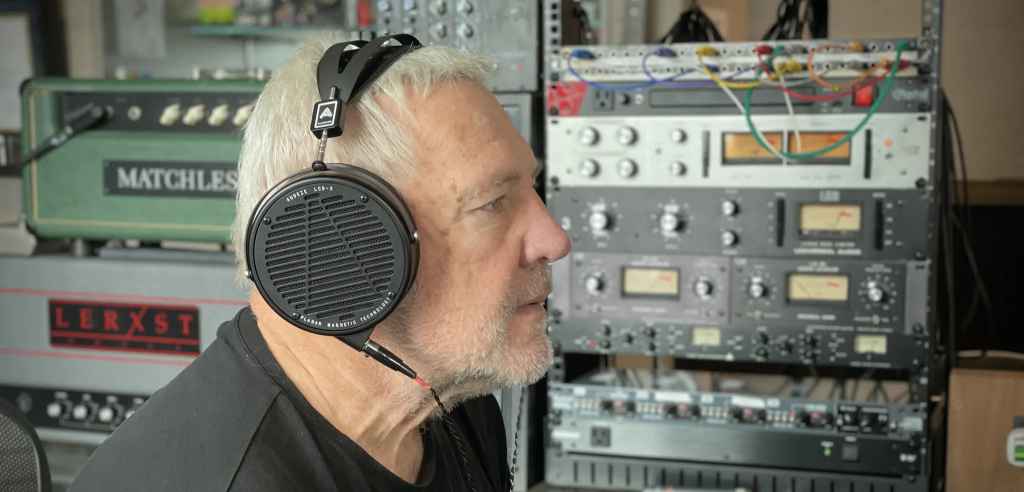
Alex Lifeson is a Canadian musician, best known as the guitarist of the Canadian rock band Rush.

Elliot Scheiner is an engineer and producer. He started working for Phil Ramone at his A&R studios which at that time was considered one of the best studios in the country.

James 'Jimmy T' Meslin is a Grammy winning recording, mix, and live sound engineer based out of Long Island, NY. He's probably best known for his work with prog-metal giants Dream Theater and their affiliated projects.

Dave Way has been mixing longer than he hasn’t. Platinum albums, No. 1 singles, 4 Grammys, 19 Billion streams with names like Michael Jackson, Fiona Apple, P!nk, Xtina Aguilera, Ringo Starr, Iron And Wine, Sheryl Crow, Marshmello, Fall Out Boy, Kesha, Macy Gray, TLC, Victoria Monet, Sons Of Anarchy, Tracy Chapman, Ben Folds, John Doe, MC5, Spice Girls, Weird Al, Paul McCartney, Bobby Brown, Mick Jagger and many, many more.
While dynamics and planars make up the majority of headphones used by audiophiles, the different flavor of resolution and airy soundstage offered by electrostatics sometimes makes them the headphone of choice. Since electrostatics have no magnets and are very light weight, the transducers seem to just melt away, providing an extremely comfortable and immersive auditory experience.
The principle behind the operation of an electrostatic headphone is quite simple. The electrostatic transducer consists of a diaphragm with a constant charge, sandwiched between two acoustically transparent stators separated by spacers. The music signal is applied to the stators in the form of equal but opposite high voltage pulses. In other words, when a positive voltage is applied to one stator, an equal but opposite negative voltage is applied to the other stator. As a result, the diaphragm is pulled towards the stator with negative voltage and pushed away from the stator with positive voltage. Thus the diaphragm moves with the music signal and this movement produces sound.
A transducer designed in this fashion is said to be in push-pull configuration. When properly implemented, this results in the same amount of force over the diaphragm, irrespective of where the diaphragm is between the stators, which produces a linear response that does not change with gain and has vanishingly low distortion.
In a conventional electrostatic transducer, the diaphragm consists of a thin film with resistive coating that holds a charge. Variations in the thickness of this resistive coating cause non-uniform driving force which results in distortion. Coating both sides of the diaphragm can make this worse because thickness variations between the two coatings will lead to even more distortion. The resistive coating material needs to be very stable and not deteriorate or lose adhesion over time, since this will result in degradation of performance.
The original source of inspiration for our exploration into electrostatic technology was to improve the quality of care for MRI patients. We collaborated with researchers from the UCLA Semel Institute of Neuroscience and Human Behavior, along with the industrial designers at BoomBang, to create a patient-friendly headset for use in MRI machines. The goal was to make it easier for doctors to deliver instructions to their patients while improving the accuracy and comfort of the MRI scan process. [Read more about the challenges of making the medical headset here.] Based on the high performance of the medical headset, we decided to transpose this technology to a consumer audiophile headphone, which we call CRBN.
There are a number of design considerations to get the best out of an electrostatic transducer. With CRBN, we set our goals very high. We wanted to design an electrostatic headphone that is efficient, with imaging, clarity, resolution and transparency that are best-in-class. We also wanted a frequency response that is neutral, with smooth treble and well extended bass (this last one is not easy!). We optimized every aspect of the electrostatic transducer design to meet these design goals.
CRBN is the first consumer electrostatic headphone in the world to use our innovative, Patent-pending carbon nanotube suspended diaphragm technology. This carbon nanotube technology solves many of the major challenges associated with electrostatic transducers.
Instead of using a resistive coating for the diaphragms, CRBN uses an ultra-thin diaphragm with carbon nanotubes directly suspended inside the material. By controlling the density of carbon nanotubes in the film, we are able to adjust the resistivity of the diaphragm material. Because the charge is uniformly distributed throughout the film, this results in a uniform driving force without the distortions associated with typical resistive coating. Unlike resistive coating, the carbon nanotube suspended diaphragm is immune to the elements and does not degrade over time.

Electrostatic headphones have a reputation for less than stellar bass response. The Audeze solution to this well-known issue involves several angles. Our carbon nanotube diaphragm allows us to achieve high efficiency by holding more charge and preventing charge migration. This allows us to reduce diaphragm tension and increase the space between the stator and diaphragm, which provides for higher excursion and lower resonant frequency without the risk of the diaphragm coming into contact with the stator. This low resonant frequency, combined with a large diaphragm surface area, acoustically transparent damping material, and custom designed earpads provide extremely well-extended bass response down to 20Hz.
In designing the CRBN driver, we chose an optimal diaphragm and stator size large enough to provide excellent bass and imaging without compromising on treble. Our stators are made using a proprietary PCB manufacturing technique that allows us to achieve high rigidity, uniform thickness and consistent flatness, which is important for equal force distribution and linear response.
The perforation of the stator is optimized for excellent high frequency extension and its conductive surface is specially coated to ensure high dielectric strength, allowing for an open airy sound while maintaining high efficiency and durability. Our super lightweight diaphragm has naturally low interia that allows for extremely fast acceleration. We employ a special edge-damping technique to further reduce distortion and smooth the frequency and phase response.
As a result, CRBN is transparent and highly resolving across the entire audible spectrum, with excellent transient response, sparkling clarity, and bass response that’s unmatched in the electrostatic arena. Another example of Audeze’s commitment to Uncompromised Audio.